| Srl | Item |
| 1 |
ID:
178885
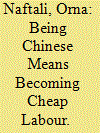

|
|
|
|
|
| Summary/Abstract |
Since the 1990s, the Chinese party-state has attempted to teach its youth how to think and speak about the nation through a “patriotic education” campaign waged in schools, the media and on public sites. The reception of these messages by youth of different social backgrounds remains a disputed issue, however. Drawing on a multi-sited field study conducted among rural and urban Han Chinese youth attending different types of schools, this article explores the effects of the patriotic education campaign on youth conceptions of the nation by examining the rhetoric high-school students employ when asked to reflect upon their nation. The study reveals that a majority of youth statements conform to the language and contents of the patriotic education campaign; however, there are significant differences in the discursive stances of urban youth and rural youth and of those attending academic and non-academic, vocational schools. These findings call into question the party-state's current vision of China as a “unified” national collectivity. They highlight the existence of variances in the sense of collective belonging and national identity of Chinese youth, while underscoring the importance of social positioning and perceived life chances in producing these variances.
|
|
|
|
|
|
|
|
|
|
|
|
|
|
|
|
| 2 |
ID:
122070
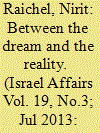

|
|
|
|
|
| Publication |
2013.
|
| Summary/Abstract |
The article deals with the dream and the reality during the development of vocational education in Israel from 1948 to the end of the twentieth century and refers both to education for manual labour as a value and to the attempt at practical guidance of students towards productivity and vocational education. It describes the gap between leaders' statements - declaring their commitment to educate the younger generation to be productive and work oriented - and the actual focus on policies of expanding academic high schools while marginalizing vocational schools time and time again.
|
|
|
|
|
|
|
|
|
|
|
|
|
|
|
|
| 3 |
ID:
134365
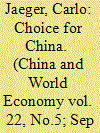

|
|
|
|
|
| Summary/Abstract |
Green growth cannot succeed without significant changes in the education system and the closely related social division of labor. This paper combines historical evidence and a game-theoretic analysis to study the relation between vocational education and green growth. It is found that a low-vocation and a high-vocation equilibrium can be distinguished in the interplay between education and labor markets, and that a high-vocation equilibrium is better suited for green growth. At the present stage of development, there are tendencies in both directions in China. Therefore, China has the possibility to successfully implement a green growth strategy by developing a strong vocational education with Chinese characteristics.
|
|
|
|
|
|
|
|
|
|
|
|
|
|
|
|
| 4 |
ID:
094988
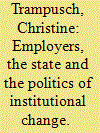

|
|
|
|
|
| Publication |
2010.
|
| Summary/Abstract |
An in-depth comparison of Austria, Germany and Switzerland shows that the employers' constellation and the elites of the public education administration affect patterns of institutional change. If large firms are the dominant actors and collaborate with elites in the public education administration, institutional change follows a transformative pattern. If small and medium-sized firms are in a strong position and have the power to influence public elites according to their interests, self-preserving institutional change results. The article also shows that it is not so much trade unions as small and medium-sized firms that act as a brake on transformative change. The article adds to the literature of institutional change by arguing that specifying and explaining patterns of institutional change requires that sufficient scope be allowed for actors' creative handling of institutions. It also suggests that in order to differentiate between self-preserving and transformative change, one has to specify the important institutional dimensions that sustain an institution. The article combines Mill's method of agreement and difference.
|
|
|
|
|
|
|
|
|
|
|
|
|
|
|
|
| 5 |
ID:
158552
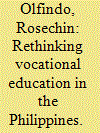

|
|
|
|
|
| Summary/Abstract |
Vocational education is often seen as a means of enhancing the earning potential of disadvantaged workers — those with lower levels of general formal education, or without adequate skills to integrate into the labour market. International evidence on the effects of vocational education on earnings is mixed. An earlier study on the Philippines indicated that this type of education can increase the wages of low-educated workers. However, by using a more recent household survey and employing alternative statistical techniques, this paper finds contrasting evidence. The new estimates indicate that workers who obtained vocational education do not earn significantly more than those who did not. The differences in estimates imply that the wage effects of vocational education among Filipino workers remain unclear. Therefore, caution must be exercised while making policies that aim to promote vocational education as an alternative to general formal education.
|
|
|
|
|
|
|
|
|
|
|
|
|
|
|
|
| 6 |
ID:
188819
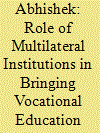

|
|
|
|
|
| Summary/Abstract |
Regime change and opening of the market brought many opportunities as well as challenges to Romania. In terms of economy, growth stagnated, unemployment increased and a reverse movement of labour took place, from more productive manufacturing and services to agriculture. Need to reskill the workers to attract foreign direct investment was felt. Two multilateral institutions, World Bank and European Union (EU), stepped in. EU, through its Phare programme, played an important role in this reskilling by providing necessary funding and experience for the restructuring of vocational education and training. The article, based on both the primary and secondary sources, examines the role played by the multilateral institutions and argues that although Phare VET programme failed short of what it was intended in many areas because of some planning and operational shortcomings, it was quite a successful programme in terms of initiating curriculum development, introducing modularization, acquainting Romanian VET schools with modern equipment and pedagogy, and planted the seeds of social partnership in the field of VET.
|
|
|
|
|
|
|
|
|
|
|
|
|
|
|
|
| 7 |
ID:
101034
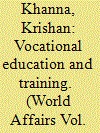

|
|
|
|
|
| Publication |
2010.
|
| Summary/Abstract |
This article on a holistic approach to vocational education and training (VET) and explores the framework, relevancy and priority of its demands in the context of India. It also analyses the connection between VET and employment, the competitiveness and the unorganized sector of the economy. Other variables which encourage the growth of VET and other related matter4s are also examined. The last section of the article discusses the use of world - class technology involving artificial intelligence for capacity building in education and training, operating the internet as a problem
|
|
|
|
|
|
|
|
|
|
|
|
|
|
|
|